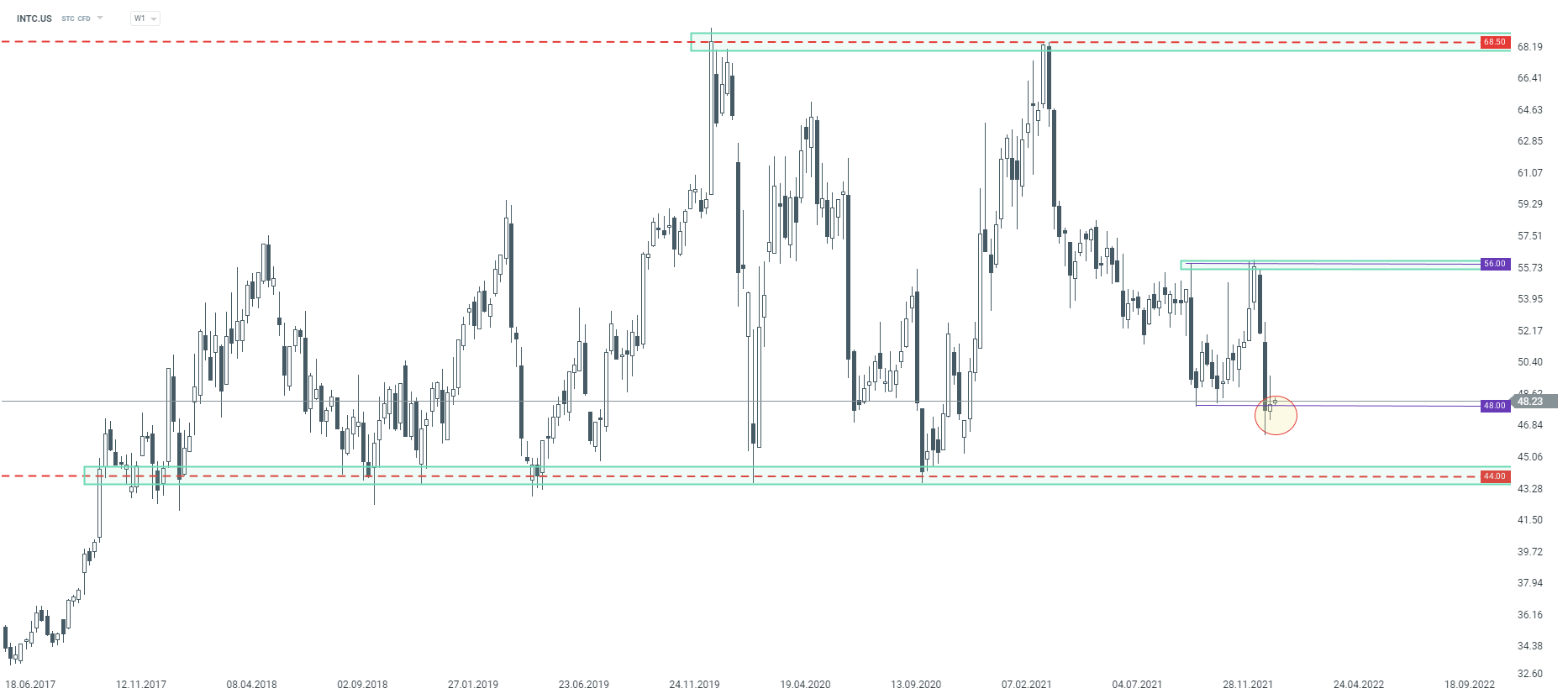Intel (INTL.US) is one of the world's largest technology companies and a supplier of state-of-the-art computer equipment. The company has been competing for years with Advanced Micro Devices AMD.US, whose stock price has fared somewhat better recently thanks in part to its announced partnership with Meta Platforms to supply EPYC processors and the success of units such as Ryzen and Radeon.
In the context of Intel, it is worth mentioning that despite a weaker recent period due to a lack of catalysts for speculative growth in the stock and a now concluded lawsuit in Europe, the company has its own 'blue chip' factories, which gives it a strategic advantage in terms of potential supply chain issues. No such factories exist for AMD or NVidia, which depend on Samsung's SMSN.UK and Taiwanese supplier Taiwan Semiconductor Devices TSMC.US.
If these suppliers fail both companies could experience huge problems and production downtime. Intel, meanwhile, appears to be immune to this; plus, as a US company, it can count on the support of the US government. The problem of access to semiconductors has recently caught the imagination of investors, so in the context of these legitimate concerns, shares in AMD and NVidia could look quite risky against Intel.
In terms of production, Intel is larger than the combined capacity of AMD and NVidia, which shows the scale at which Intel operates as the world's largest chipmaker alongside Samsung. The company in January 2022 announced the construction of two massive semiconductor factories in the US state of Ohio. Construction is expected to cost USD 20 billion. Ultimately, the project is to be expanded by an additional six factories, the final investment amount will be USD 100 billion.
Intel has additionally announced that later this quarter it is to release an ARC graphics card, which will provide very tough competition for AMD Radeon and Nvidia GeForce models. According to Intel's website, the first models are expected to arrive later this quarter.
Later this year, Intel's subsidiary Mobileye, a pioneer in the self-driving market, will go public. Mobileye provides chips and software that help vehicles with automatic navigation and driving. The company has partnerships with Tesla TSLA.US and Volkswagen VOW1.DE. Mobileye has a chance to become a pioneer in popularising 'robotaxi', and its technology is to be tested in one of the world's most crowded cities, New York.
Intel owns more than half of Mobileye, having bought it in 2017 for a staggering $15.3bn. Mobileye's debut is likely to be very positively received by the market, as was the case with Rivian RIVN.US, in 2021. It was largely thanks to the successful debut of the electric car manufacturer that the company's shareholder, Amazon giant AMZN.US, was able to boast spectacular results for Q4 2021. Will a similar case await Intel this year?
In the meantime, however, the market is still awaiting further positive news from Intel, which could provide a catalyst for more dynamic increases in the company's share price in the near future.
 INTC.US quotes managed to stop last week's strong decline, however the weekly candle has a large upper shadow, which does not encourage growth. The closing of the current W1 candle may decide the direction in the medium term. In the case of a downward scenario, the zone at $44 should be considered as the next support. On the other hand, the continuation of the price above $48, may lead to another attack on the resistance at $56. Source: xStation 5
INTC.US quotes managed to stop last week's strong decline, however the weekly candle has a large upper shadow, which does not encourage growth. The closing of the current W1 candle may decide the direction in the medium term. In the case of a downward scenario, the zone at $44 should be considered as the next support. On the other hand, the continuation of the price above $48, may lead to another attack on the resistance at $56. Source: xStation 5
ซาโนฟีเผชิญแรงกดดัน หลังจาก FDA เลื่อนการอนุมัติและผลการทดลองล้มเหลว
Rivian Automotive: ดาวรุ่งหรือดาวตก? 🚗💥
DE40: ดัชนี DAX ปรับตัวขึ้น 0.5% 📈 หุ้น Lufthansa พุ่งเกือบ 5% หลังได้รับคำแนะนำเชิงบวกจาก Kepler
หุ้นเด่นรายสัปดาห์ – Jabil Inc


